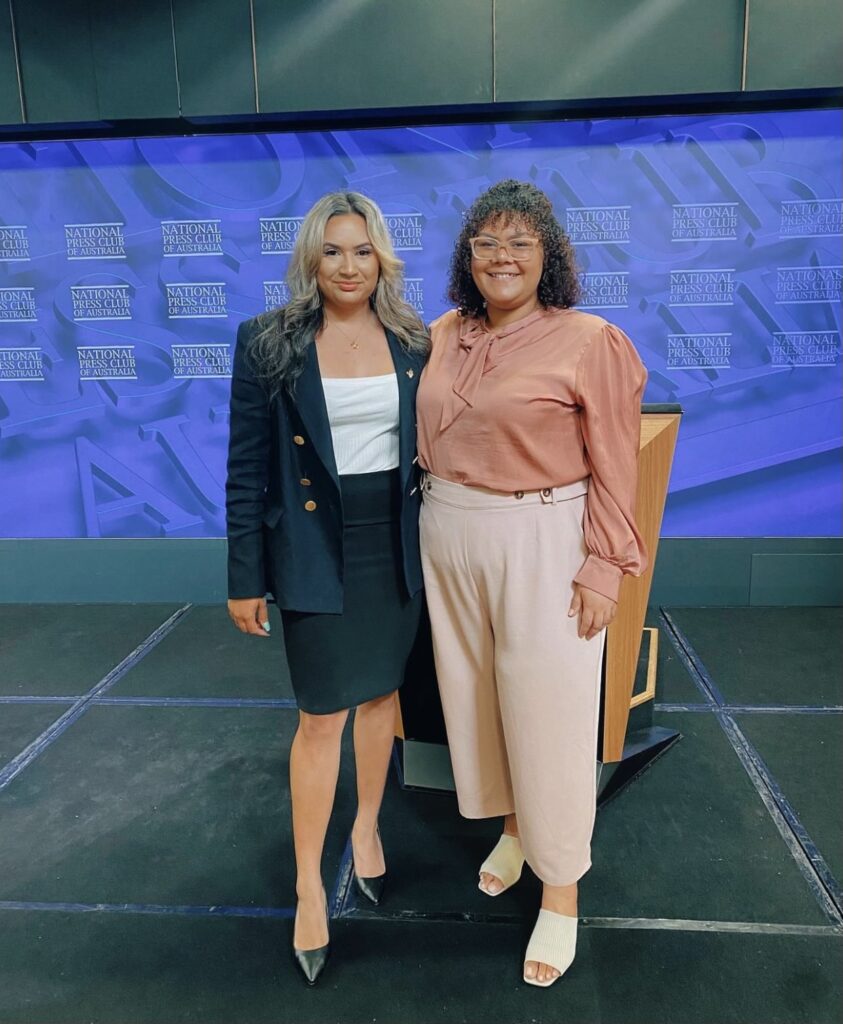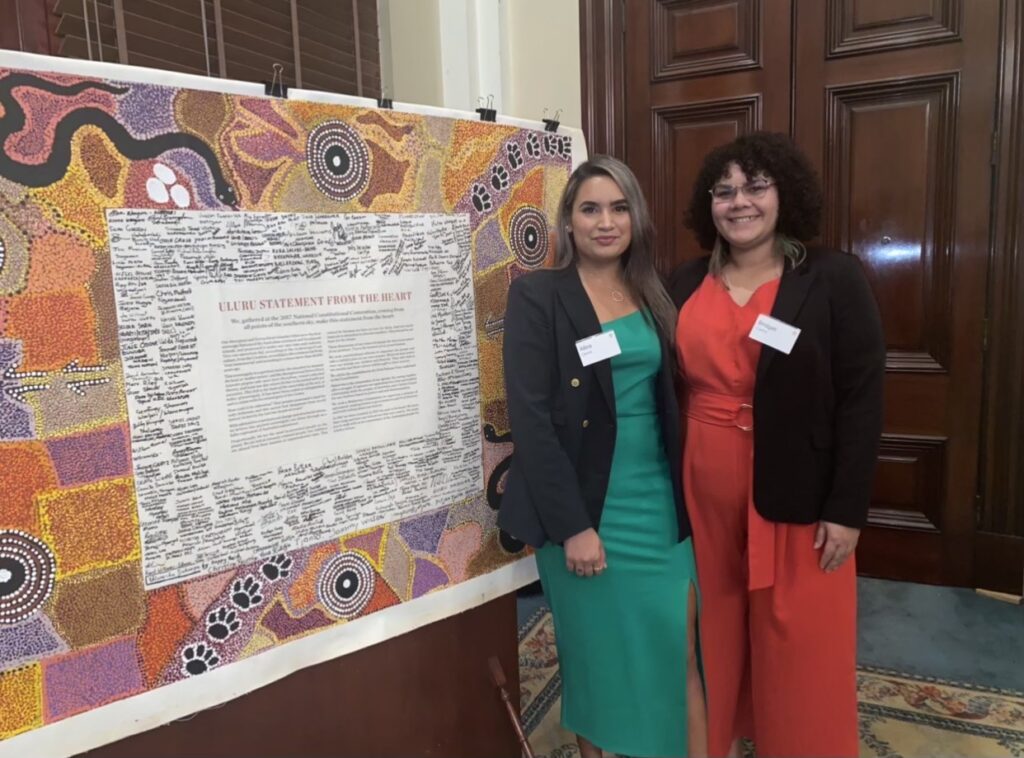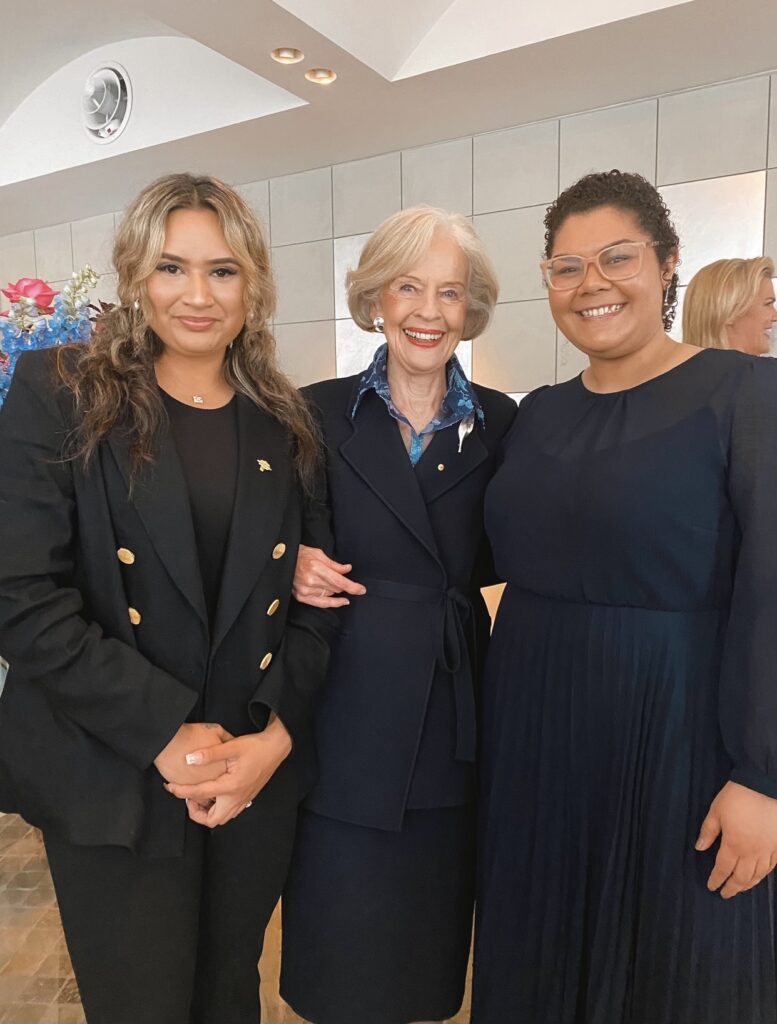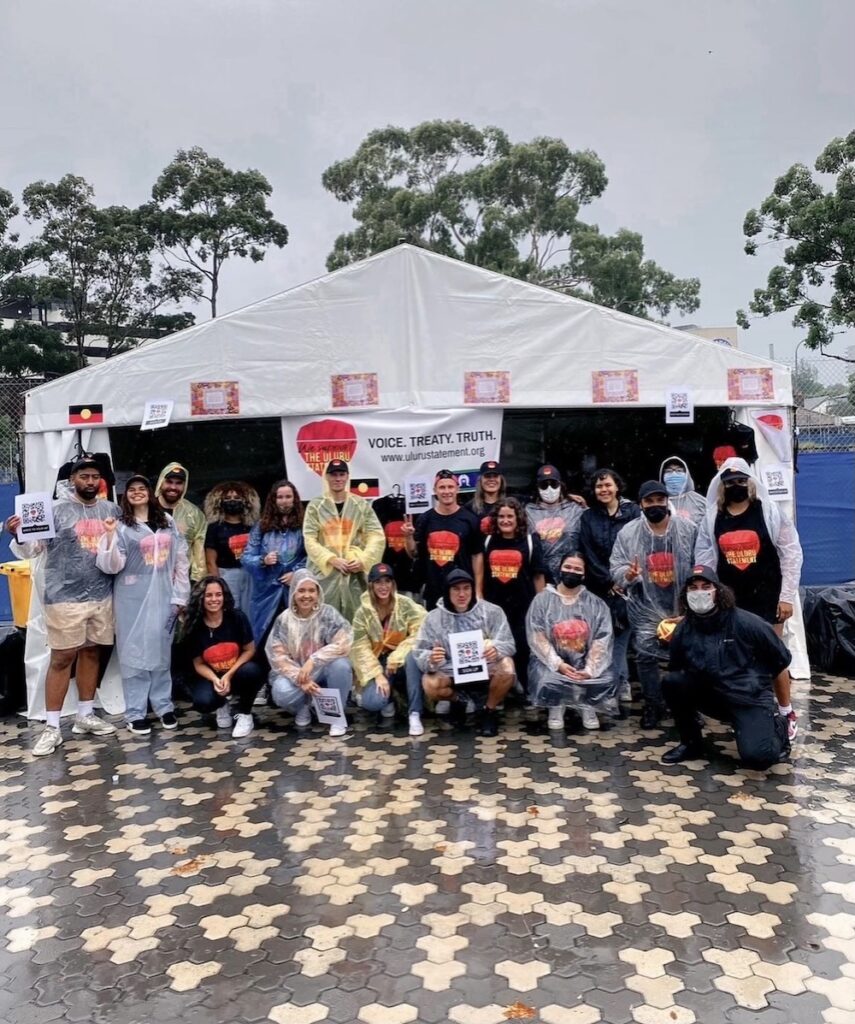Voice, Treaty, Truth: The Young People Calling for a New Australia
The country's first referendum in 24 years is taking place on October 14, putting the spotlight on a country facing a unique crossroads.
There currently exists a potency within the Australian political and social climate that has made issues affecting our day-to-day lives impossible to ignore. The combination of living in an increasingly digital and, as such, empowered age, has meant our leaders in positions of power have been held accountable more than ever before.
And when it comes to the fractured relationship between the Australian Government and our First Nations people, there has never been a more important time to take stock of the environment we live in, and have the ability to shape.
Recent years, full of frustration, dissatisfaction and trauma felt by First Nations communities nationwide have manifested into movements of solidarity playing out on the national stage. Rallies and protests to bring awareness to the continued mistreatment and displacement of First Nations Australians have been front and centre on news cycles; charged up voices refusing to be dimmed.
This year, Australia has the chance to listen. Properly listen and decide on a hugely significant change to the Constitution — one that will mean a historic shift for First Nations Australians everywhere.
The country’s first referendum in twenty-four years is taking place on October 14 2023, putting the spotlight on a country facing a unique crossroads.
Unlike the 1999 referendum, which proposed Australia become a Republic, 2023 offers Australians the opportunity to enact a historic change to the Constitution; recognising the First Peoples of Australia by enshrining an official Aboriginal and Torres Strait Islander voice.
The Voice itself is a proposed independent, permanent advisory body, that would advise the Australian Parliament and Government on the matters and policies that affect Aboriginal and Torres Strait Islander peoples nationwide.
Love Music?
Get your daily dose of everything happening in Australian/New Zealand music and globally.
An embedded Voice within the Australian Constitution stands to be groundbreaking if it is brought to fruition. Not only does it guarantee First Nations communities an avenue to help inform the legal decisions that impact their lives, but it will stand as a permanent seat at the table — one that successive Governments cannot remove.
Since the 1920s, there have been First Nations advocates fighting for their right to be heard, their perspectives acknowledged, their advice implemented within Australian society. Now, over one hundred years later, the permanence of an official Voice to Parliament is up for discussion.
In June, the passing of a bill to alter the Constitution and enable The Voice passed in federal parliament; fifty-two votes to nine leading the Senate to pass the bill, ultimately confirming the wording of constitutional change that will be proposed to Australians. Though a critical moment in Indigenous history in Australia, the passing of the bill — just like The Voice in general — brought heated conversation from both sides.
THE ULURU YOUTH NETWORK
In the throes of this push for change is a group of passionate young First Nations peoples who have come together over a shared goal for justice, and a permanent shift, when it comes to the acknowledgement of Australia’s First Peoples.
Co-chaired by Allira Davis and Bridget Cama, the Uluru Youth Network has been crucial in providing a platform for young First Nations people who are passionate about structural and constitutional reform, to campaign and fight for change in a space that can have impact.
Davis, a Cobble Cobble woman from the Barungum and Birrigubba Nations — and Cama, a Wiradjuri First Nations and Pasifika Fijian woman from Lithgow, NSW, and with connections to the Cudgegong River outside Mudgee, have been working together since 2019.
Meeting at a senior leadership dialogue driven by The Uluru Dialogue, both Davis and Cama realised quickly that though there were many voices in the room advocating for positive change, an important one was missing. That of the youth.
“We bonded over that and a common goal, a common justice.”
“We knew that young voices were missing,” Davis explains.
“We knew that we needed a youthful perspective. We needed young people’s perspectives and opinions, so we created the Uluru Youth Network in 2019. We held the Uluru Youth Summit in 2019. We bonded over that and a common goal, a common justice. We come from similar yet different backgrounds, but we somehow work really well together.”

Uluru Youth Dialogue Co-Chairs Allira Davis and Bridget Cama at the National Press Club for the Sydney Peace Prize.
VOICE, TREATY, TRUTH
The Uluru Youth Network directly works with the Uluru Dialogue which, in itself, represents the cultural authority of the Uluru Statement. The Statement, born out of a series of dialogues held across Australia, culminated in a National Constitutional Convention held at Uluru in 2017.
In its final form, The Uluru Statement From The Heart exists as an invitation to the Australian people to walk with First Nations peoples in creating a new future through a series of key reforms.
Key to the statement is the establishment of The Voice, and a Makarrata Commission, to supervise a process of creating agreements and truth-telling about First Nations history.
Over 250 delegates signed their names to The Statement; these voices came together to advocate for a new Australia that can truly start to benefit its First Nations peoples. As Cama reflects, the importance of laying a sustainable foundation for young people, and generations to come, is a key element of The Statement.
“There were youth delegates to the Uluru Convention, they’re signatories to the statement itself,” she states.
“There’s over 250 signatures and young people are part of that. You only need to look at the Uluru Statement to see what the delegates to the regional dialogues talked about. They talked about young people. There’s so much emphasis on young people and our future generations. They did that hard work so that young people and future generations aren’t experiencing the same thing that they experienced.”
BUILDING THE ULURU YOUTH DIALOGUE
The creation of the Uluru Youth Dialogue in 2019 landed with urgency but, unbeknownst to everyone involved, would be the last chance for in-person networking, sharing, and learning for the short-term future.
Taking place in Cairns over three days at the end of 2019, Davis and Cama developed programming that encouraged and nurtured the shared passions of those in the burgeoning collective.
Davis notes that the confidence and conviction in everyone’s belief was already well-established, but the Uluru Youth Dialogue simply existed to give them the step up they needed to have their presence solidified.
“We just wanted to boost them up with the resources and support,” she tells Rolling Stone. “I don’t think I’m necessarily a manager, but I think I’m someone who is just helping another young person be provided with the tools to go out and inform their communities about the Uluru Statement.”
“By that point, Bridget and I were bawling our eyes out.”
Over fifty young First Nations people gathered to discuss the Statement, and learn about its mandate of ‘Voice, Treaty and Truth’. Across the duration of the dialogue, the members of the Uluru Youth Network were able to identify tangible actions they could take home to their community, where the work on ground would continue.
“By that point, Bridget and I were bawling our eyes out, because we were just so amazed by the calibre [of people],” Davis remembers.
“We shouldn’t be shocked at all, but it’s just all the very like-minded people in the room. It was such a powerful experience for both of us, and very purposeful as well.”

Allira and Bridget at the Australian Women’s Weekly lunch.
STRENGTH BUILT UPON STRENGTH
For both Davis and Cama, their work in this space would not be possible without the support of their elders and community leaders, whose tireless work in the years previous to their entry to this realm had already begun to open doors.
When they met and developed the Uluru Youth Network, both Davis and Cama were in the early stages of their careers. Davis, having worked in the public and private sectors, came into the Co-Chair role after a number of years volunteering for the Uluru Dialogue. Cama, meanwhile, arrived after completing a Law Degree at UNSW, before landing a research assistant role for Professor Megan Davis.
Now spearheading a collective of their own and becoming models of influence themselves within the Uluru Youth Network, the Co-Chairs reflect on their evolution and the support they have received from those who have come before them.
“It’s been a pretty unique space to work in, we have two amazing Co-Chairs of the Uluru Dialogue who are women, and they have such a unique style of leadership,” Cama says of Professor Davis and Patricia Anderson AO.
“The strategic thought that goes into guiding our campaign of the Uluru Dialogue is filled with immense intelligence, lived experience; commitment and taking the mandate of the Uluru Statement and what First Nations people said really seriously. There’s a lot of love and generosity too.”
“Allira and I are both two young women, very early in our careers, who have the opportunity to create this space. That’s only come because we’ve got the support of our senior leadership. There’s a lot of awesome men in that space as well; they gave up their space to allow us to do this work. To allow young people to be active.”
NO PROGRESS WITHOUT CHALLENGE
Of course, the journey towards structural, political, and societal reform is rarely a smooth one. For Davis, Cama, and the Uluru Youth Network, the onset of COVID threw the most unexpected of spanners into the works.
Isolating the collective from one another and stunting the momentum generated at the youth summit at the end of 2019, Davis and Cama were forced to engage the level of generational resilience inbuilt in both of them, to keep the spirit and core message alive.
Davis spotlights the work her family has been doing in the community for years as continued inspiration. Stoking the passion she brings to her work, she is driven by the potential that young people (and Australians generally speaking) have to set new standards and achieve a positive ripple effect of change.
“When you know what our people go through, you really gain a strong passion and strength; resilience to just keep going in fighting for what’s right and impacting change,” she says.
“A lot of my aunties and uncles, my mother, have been involved in our community since they moved down to Eagleby (South East Queensland). Just having role models and people to look up to, people who fight every day and work in communities to fight the injustices our people will experience, gives you an open mind. People work so hard in communities — props to people who do work in communities, because it’s a hard job.”
Knowing the Uluru Youth Network had the support of the Uluru Dialogue, and those elders who maintained stature and positions of leadership and influence, was an important ingredient; particularly when things were at their most unsettled.
“This has grown really organically, it’s not something we had this big plan of doing,” laughs Cama. “It’s grown over time and we’ve had to be flexible. We’ve lasted through two or three years of COVID; that required us, as Co-Chairs, to be creative and think, ‘How do we keep our young people engaged through a global crisis?’ We were talking about bigger picture stuff when [the elders were] trying to deal with the every day of COVID. It’s definitely the most challenging work that I’ve ever done in my life, but it’s also the most rewarding.”
“Having the support of elders and of senior people in the Uluru Dialogue, and in our own communities, really gives us a sense of purpose. To have them behind us in this work just means so much; it means that we can do our work in a meaningful way. In a culturally appropriate way too, to make sure that everything is done properly, whilst also just driving this on the ground. We see ourselves as the little foot soldiers for our elders, who have paved the way and allowed us to have the opportunities we’ve had. We wouldn’t have that without our elders’ decades worth of advocacy and fight for justice.”

Allira and Bridget with former Governor-General Quentin Bryce at the Sydney Peace Prize award ceremony at Sydney Town Hall.
THE MARATHON [TO REFERENDUM] CONTINUES
With mere weeks to go until Australia heads to the ballot post, the work of the Uluru Youth Dialogue isn’t slowing down. Campaigning to educate Australians about The Voice, The Uluru Statement From The Heart, and more importantly, the weight each vote has, continues through their work.
“Not all First Nations people are going to agree.”
And knowing that the conversation surrounding The Voice and the proposed reforms in The Uluru Statement From The Heart has been a divisive one as even within First Nations communities, there isn’t 100% consensus on the vote either way.
“Not all First Nations people are going to agree,” Davis admits.
“I think that throughout the dialogue process, people should realise that once the First Nations voice is enshrined into the constitution, there’s still a process after that where we have to talk about the model and yarn to communities about what it is. It’s all about community members, community leaders, and people who feel voiceless, having a voice.”
“Because it’s in the constitution, it doesn’t mean it’s going to be [affecting only] the top level – these Aboriginal and Torres Strait Islander leaders who have been there since day dot. It will be the people on the ground actually being affected by these policies.”
Although their work has already generated groundswell and support in the wider First Nations arena, meaningful conversations can’t be a one-and-done situation. Education is, and remains, key.
“We have a huge amount of support behind us already, a lot of goodwill from Australians,” she says.
“There are still a lot of people who don’t know a lot about it, who don’t know how they’re going to vote. That’s where the conversations are most important. At the end of the day, we just want to make sure that Australians feel like they can make an informed decision.
“You have to make a decision that aligns with you, as a person. It is a privilege to vote. We’re very privileged in this country, to have a right to vote. It is the Australian people, through this vote on the referendum, that will be able to shape what the future of Australia looks like. As young people, I think we feel that immensely.”
Regardless of what side of the referendum you fall on, there’s no denying that Australia sits on the precipice of massive change. Recognising the importance of one’s right to vote is the first important step Australians can take, no matter how you’re deciding to use it.
“If the referendum is not successful, we will bear the consequences of that. If the referendum is successful, then we can start to move forward.”
The Uluru Youth Dialogue at the Parramatta Indigenous All Stars 2022.
“If the referendum is not successful, we will bear the consequences of that. If the referendum is successful, then we can start to move forward as a nation and as peoples. Most importantly, as Australians, start to unpack and address some of that unfinished business,” Davis adds.
“There’s a lot of noise out there, so we need to focus on what this actually is. Keep it out of politicians’ hands. It was gifted by First Nations people to the rest of Australia to walk with us. It is a people’s movement, it always has been. This is not about politicians or politics. It’s about creating an Australia we want to live in, and that we’re proud of.”
This article features in the September 2023 issue of Rolling Stone AU/NZ. If you’re eager to get your hands on it, then now is the time to sign up for a subscription.
Whether you’re a fan of music, you’re a supporter of the local music scene, or you enjoy the thrill of print and long form journalism, then Rolling Stone Australia is exactly what you need. Click the link below for more information regarding a magazine subscription.




































